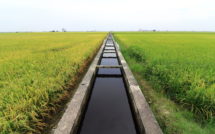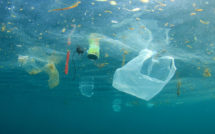

This is part of our Campus Feature on Water Centers & Institutes.
The Pacific Institute is a global water think tank that combines science-based thought leadership with active outreach to influence local, national, and international efforts in developing sustainable water policies. Based in Oakland, California, the Institute’s mission is to create and advance solutions to the world’s most pressing water challenges. The Pacific Institute was founded in 1987, when a small group of researchers in Berkeley, California came together with a shared vision of bringing new ways of thinking, seeing, and doing to pressing environmental and social problems. Out of this vision came the Pacific Institute for Studies in Development, Environment, and Security.
Since then, the Pacific Institute has carried out independent research and outreach to improve how threats to sustainability are perceived and solved. For instance, the Pacific Institute pioneered the “soft path” to water. The soft path recognizes that there are two ways of meeting water needs, or more poetically, two paths. The “hard” path relies almost exclusively on large-scale, centralized infrastructure and decision making using technology and institutions developed in the nineteenth and twentieth centuries: large dams and reservoirs, pipelines and treatment plants, public water departments and agencies, and private companies. The objective of the hard path is to deliver water, mostly of potable quality, and sometimes to remove wastewater. The soft path, by contrast, has a broader set of goals: the delivery of water-related services matched to users’ needs and resource availability. It seeks to take advantage of the potential for decentralized facilities, efficient technologies, flexible public and private institutions, innovative economics, and human capital. It strives to improve the overall productivity of water use rather than seek endless sources of new supply. It works with water users at local and community scales and seeks to protect critical ecological services—such as nutrient cycling, flood protection, aquatic habitat, and waste dilution and removal—that water also provides.
A key element of the Institute’s work over the years has been to examine the role of water conservation and efficiency. The 2003 report Waste Not Want Not: The Potential for Urban Water Conservation in California was the first comprehensive assessment of the potential and cost of water conservation and efficiency. The study concluded that existing technology could reduce urban water use by up to one-third, and at least 85 percent of the savings could be realized at lower cost and with fewer social, environmental, and economic impacts than new supplies. These estimates, far larger than previously thought, fundamentally shifted perceptions about demand management, from being viewed as a short-term drought response strategy, to being viewed as critical for ensuring long-term water supply reliability. Subsequent work provided a first-of-its-kind statewide analysis of the opportunities for improved efficiency in agricultural and urban water use, water reuse, and stormwater capture (The Untapped Potential of California’s Water Supply) and the relative cost of these options (The Cost of Alternative Water Supply and Efficiency Options in California).
In addition, the Pacific Institute has long played an active role at the Salton Sea, a fertile oasis in the hostile desert of southeastern California used by millions of birds migrating along the Pacific Flyway. The Institute produced three leading reports on the Sea, including Hazard’s Toll, outlining the importance of the Sea and the likely economic consequences of failing to act on its behalf. It has developed restoration concepts for the Sea, participated on the state’s Salton Sea Advisory Committee and in the current Salton Sea Management Program workgroups, and continues to work actively with state agencies and local stakeholders to get real habitat constructed on the ground to benefit at-risk species, and to diminish the amount of dust blowing off of the Sea’s exposed lakebed.
Collaborative partnerships are core to the Pacific Institute’s approach. By establishing mutual interests with various stakeholders, the Institute has been able to focus its science-based solutions towards shared goals, building cross-sector alliances to tackle complex water challenges. The Institute’s efforts to establish shared interests and goals with a broad array of stakeholders—including communities, businesses, civil society groups, private sector organizations, and governments—have resulted in a number of participatory research models, collaborative platforms, and formal partnerships.
One such example is the United Nations Global Compact’s CEO Water Mandate. The Pacific Institute serves as the Co-Secretariat for the CEO Water Mandate, a unique public-private initiative established in 2007 that mobilizes business leaders to address global water challenges through corporate water stewardship, in partnership with the United Nations, governments, civil society organizations, and other stakeholders. Implemented in partnership with the United Nations Global Compact, the CEO Water Mandate offers a unique platform to share best and emerging practices and to forge multi-stakeholder partnerships to address challenges related to water scarcity, water quality, water governance, and access to water and sanitation. The CEO Water Mandate is endorsed by more than 140 businesses across a wide variety of industry sectors and geographies around the world. Endorsers of the Mandate commit to continuous progress against six core elements of water stewardship and to annual progress reports. The Mandate supports endorsing companies by developing guidance, collaborative tools, case studies, and other resources; facilitating collective action and policy engagement; and supporting increased uptake of stewardship best practices.
One of the CEO Water Mandate’s current projects is focused on improving water security in the Noyyal and Bhavani basins in India, home to numerous apparel mills and factories. The project’s activities include conducting basin and facility water assessments to aid facilities in setting their own water targets and prioritizing solutions to address shared basin water challenges and reduce business water risk. Among the Mandate’s other projects and initiatives is the Water Action Hub, an online stewardship collaboration and knowledge-sharing platform which features projects in river basins and regions around the world; and the Water Stewardship Toolbox, with tools, guidance, case studies, and datasets from dozens of participating organizations.
In an ongoing effort to understand the connections between water resources, water systems, and international security and conflict, the Institute initiated a project in the late 1980s to track and categorize events related to water and conflict. The Water Conflict Chronology database, updated in May 2018, includes more than 550 instances of violence over water from 3000 BC to the present categorized into three groups: the use of water or water systems as “weapons” of conflict; water as a “trigger” of conflicts; and water resources as “casualties” of violence. The Institute has found that reducing water-related conflict would require a multifaceted approach, including measures such as improving water efficiency; investing in wastewater and treatment and reuse; expanding and enforcing international law; and improving the effectiveness and legitimacy of governance systems.
In 2016, Jason Morrison became president of the Pacific Institute, replacing Peter Gleick, who co-founded and led the Institute for 29 years. Peter Gleick now serves as President Emeritus. The Institute’s main office is located in Oakland, California, with additional offices across the United States, Brazil, and the United Kingdom.
Rebecca Olson is Communications Manager at the Pacific Institute. She holds a B.A. in Interdisciplinary Studies from UC Berkeley, where her research focused on gender studies and international relations.
The answers to the water challenge go beyond academia and traditional policy channels. They call for a broader engagement of civil society, which is why, by way of illustration (without endorsing), we include the perspective from philanthropy, business and NGOs as well as a few profiles of mission-driven water centers and institutes.
Photo: Water droplets on background | Shutterstock
Published on December 11, 2018.




